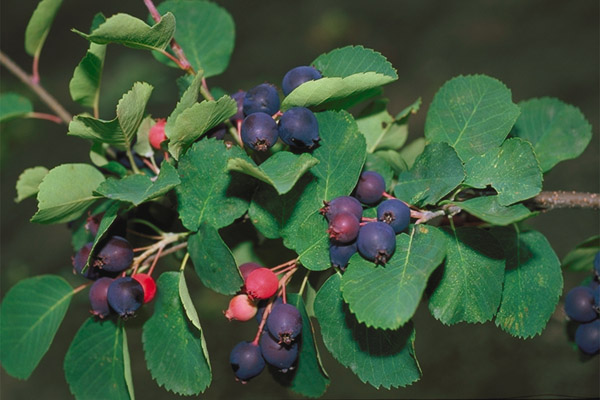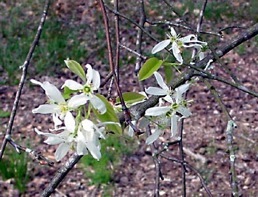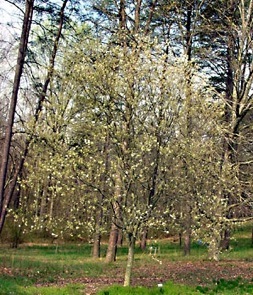Amelanchier arborea: Busting Out All Over
Juneberries are as American as apple pie. In fact, they are more American than apples.
While Juneberries are native, cultivated apples are not. When the Europeans arrived in the New World there were only sour crab apples, but plenty of sweet Juneberries, Amelanchier arborea (am-meh-LANG-kee-er ar-BORE-ee-uh.) Juneberries, however, are a close relative of the apple and have been under cultivation since 1746.
Juneberries were one of the famous traditional ingredients in pemmican, which was fat and powdered meat, or, fat, powdered meat and dried berries. Throughout the cooler areas of North America Indians made “pimekan.” It was not only a staple for the northern Indians but became the main ration for European backwoodsmen and traders. Interestingly the practice among the Indians of making pemmican did not go much farther south than Missouri or Nebraska, by Osage and the Omaha. The Missourians also mixed their Juneberries with cornmeal to make cakes, which was more in keeping with what southern tribes did. Southern Indians also made more stews and used more plants in those stews than the northern Tribes.
Opinions vary whether the Juneberry is better fresh or dried or cooked. It is a matter of personal taste. Some recipes are included below. Several species have been used for food including A. alnifolia, A. bartramiana, A. canadensis, A. intermedia, A. laevis, A. lamarckii, A. pallida, A. sanguinea, A. spicata, and A. utahensis. Species in Europe and Asia are also eaten though there is only one naturalized species of Juneberry in Europe, A. lamarckii. The Juneberry can be a multi-branched shrub or a tree to 50 feet. Like the Eastern Redbud it usually flowers in the spring before leaving out. A. arborea can be identified from the others by fuzzy emerging leaves, greenish-yellow buds, and pendulous fruit.
Amelanchier is a French corruption of the Gaulois’ word “amelanco,” thought to be their name for that plant or a similar one. Scholars guess that “amelanco” is a combination word that means little apple or downy apple. Arborea means tree-like. Besides Juneberry and Serviceberry the plant is also called Sarvis and Sarvis Tree. “Service” and “Sarvis” have the same origin in the written word “service.” Why “service?” The tree was called that be cause in Appalachia it was the only tree blossoming when it came time to bury in the thawed ground of spring those who had died during in the winter. Farther north along the coast it was called Shadbush, Shadblow, Shadwood because it
blossomed when the shad (migrating fish) were running. Other names include Saskatoon (a shortened Cree name) Sugarplum, and Wild-plum. It was called Juneberry because in many places the fruit ripens in June, usually the first of the new year for those weary of winter fare. The European species honors Jean Baptiste Antoine Monet de Lamarck, an 18th century French naturalist.
Nutritionally berries contain higher levels of protein, fat, and fiber than most other fruit but are low in vitamin C. They do have pectin, however. Lastly, the Juneberry reminds us that all berries with a “crown” on one end (like a blueberry) are edible.
Juneberry Pie
Pastry for 2 crust pie
3-4 c. juneberries, washed
2 tbsp. flour
2 tbsp. lemon juice
1/2 c. sugar
1/4 tsp. nutmeg
Sugar for sprinkling
Mix all ingredients together. Spoon into pastry lined pie plate. Top with pastry cut into strips. Sprinkle top with sugar. Bake at 450 degrees for 15 t minutes then at 350 degrees for 25 minutes more.
Juneberry Jam
4 c. Juneberries, cleaned
4 c. cut up rhubarb
4 c. white sugar
Grind Juneberries and add to sugar and rhubarb. Bring to simmer. Stir and cook until thick. Burns easily. Pour into jars. Seal. I like to add 1 teaspoon cinnamon and 1 tablespoon lemon juice to my jam.
Juneberry Muffins
2 c. flour
1/4 c. sugar
3 tsp. baking powder
1/4 tsp. salt
1/4 c. shortening
1 egg
1 c. milk
1 1/2 c. Juneberries
To dry ingredients add egg, shortening, salt and milk. When well blended stir in Juneberries. Fill muffin cups 2/3 full. Bake 20 minutes, 350 degrees.
Green Deane’s “Itemized” Plant Profile
IDENTIFICATION: A small tree or multi-stemmed large shrub, rounded crown with arching, spreading branches. Trees to 20 to 50 feet, short lived, rarely beyond 50 years, often an understory tree near stream banks. . Leaves resemble apple leaves, simple, alternate, oblong, one to three inches long, serrated, downy underneath, smoother above, silvery-gray and fuzzy when emerging, dark green in summer. Fall colors yellow to orange to red. Flowers blooms in clouds of white in early spring, five-petalled, dainty, like an apple blossom, in March and April, hang in elegant clusters. Fruit a small berry-like pome, ripens in June from green to red to purplish-black. Seeds, red teardrops. An English cultivar has red berries (A. alnifolia, var. Ballerina.)
TIME OF YEAR: Usually in June in most of its range. Most of the berries ripen at the same time and can be harvested at the same time.
ENVIRONMENT: Grows best in full sun to light shade and moist, well-drained, acid soils. More common in northern areas.
METHOD OF PREPARATION: Many. Fresh berries or dried or cooked. Can be made into pies, jelly and jams; dried it can be made into cakes or used to make pemmican. Occasionally a tree will have foul-tasting berries. Find another. There are no toxic look-alikes.






I’m so happy to have found this. I think we have huge Juneberry bushes here in Finland, and nobody touches them. That thing you said about berries with a crown being edible…Is this true world wide or just to species in the US?
As far as I know, worldwide. Have you visited http://www.henriettesherbal.com/
I have a question about the juneberries.
Any records for using the leaves as tea?
According to some article , the native people used the bark like tea but some information says all part of trees are poisonus except the ripe berries.
I tried to make tea to use the leaf twice many moons ago. I didn’t know the trees in detail then.
It was really nice to drink and contains great flavor.
I ‘ve developed tea drinks and food for about 20 years in South Corea.
Hi,
I live in Sacramento CA. How can I find them in my area? Will they grow in our clime?
Excellent website,
Karie
Just got done bringing a load of Juneberries back home from western Illinois, where I planted some A. Canadensis some twenty years ago – never had the time to spend waiting for them to ripen before now. And this must be a bust out year for them -a few bushes I planted at the same time for the wildlife were just about top heavy with the amount of berries on them. The ones in my garden yielded about three gallons of ripe berries, and I must have left five times that of unripened ones. @Karie, you can get A. Canadensis from many sources, but I don’t know if you can grow them in Sacramento CA. Think they need a cooler climate.
I thought that the tip about berries with a crown referred to plants in the Rose family (Rosacae), all of which are edible. The Rose family is the source of “apples, quinces, pears, peaches, plums, apricots, cherries, blackberries, raspberries, and strawberries.” http://www.newton.dep.anl.gov/natbltn/200-299/nb277.htm
Evidently I was wrong, because blueberries are in a different family (Ericaceae)! Juneberry, however, IS in the Rosaceae family. 🙂 http://en.wikipedia.org/wiki/Amelanchier
Wonderful page. Just discovered Juneberries. It’s a bumper year for them in my neighborhood. Going to have to plant some in my yard.
Great website! I am trying to identify some small trees on our land that look like Juneberry, but the Purple berries do not have a crown. They grow in clusters like grapes and are just under 1/2″ in diameter. The leaves are similar to your first picture, but come to a point. They are loaded with berries, but I am afraid to eat them until I can be sure they are safe.
I hope you are not thinking of tasting those berries as they might be toxic Virginia Creeper.
I have two amelanchiers growing in my very small garden, one a bush type and the other a small tree. I harvest the berries as they ripen (about 3 or 4 times over the season), eat some as I’m doing the harvesting, and freeze the rest. I use the berries mostly with my cereal breakfast but they are quite tasty even when frozen. I usually nibble on the frozen berries while I’m at the computer.
I’ve been interested in trying to grow serviceberries in Gainesville for many years. The range of A. arborea extends into the Florida Panhandle, but the others are all more northern. I would like to know if anyone has selected any varieties from Florida and where I might be able to get some. A friend once got some seeds, but they never came up.
May I share a link for information on the establishment of New York’s first Juneberry research nursery by the Norther New York Agricultural Development Program, a farmer-driven research and technical assistance program for the six northernmost counties in New York State. . . The first research report on the collection of wild Amelanchier specimens by botanist Michael Burgess and Cornell Willsboro Research Farm Manager Michael Davis and the new nursery at the Willsboro, NY, farm along Lake Champlain is posted at http://www.nnyagdev.org/index.php/horticulture/juneberries-in-nny/. Please watch the web for an Associated Press story on this soon.
I believe these trees need a cold climate (which is why they won’t grow in California, Florida, sorry previous posters) and they like to grow near water. I have loads of Saskatoon trees in my area of Manitoba and when they all come ready at the same time, we spend about 2 solid weeks harvesting them. They are delicious as-is but we also freeze them and eat away at our stash all winter 🙂
Hi Green Dean! I have a lot of June Berry trees growing along the river where I live in Nova Scotia. They are blossoming right now and am wondering if the blossoms are dried and used for teas? I’m having difficulty finding information about the blossoms but I can’t see any reason why they would not be edible.
Jessica
I was having the worst time trying to grown blueberry plants in Minnesnowta. Then I discovered Juneberries and consider them a more suitable replacement. They yield a prolific harvest as compared to blueberries and they make lots of new plants for sharing with other gardeners.
I found one way to keep the neighbor kiddies from swiping too many apples or berries, which is to plant stinging nettles under my apple tree and around the berry bushes. I grown the nettles for greens (rich in iron and minerals) and also for tea. I found as the weather turns cooler and my arthritis starts acting up that rubbing stinging nettle over the sore joints in my hands helps them a lot and they also feel warmer too.
Ah, this brings back my greatest horticultural regret. As a child, there was an unusually large and vigorous Juneberry tree with large berries growing near a very old house. They were very juicy and sweet, and after a few years I realized this was a very unusual variety of the genus, perhaps an experimental cultivar (our area in NJ is near Whitesbogs, where commercial blueberries were first developed) among a number of commercialization experiments with wild plants that went on in the early 1900’s in Jersey and I decided I would try to grow more from seeds.
Alas, that year the tree was torn out before it could fruit and I’ve never found another Juneberry like it.
We have planted Juneberries on our property as well as our neighbor has some in his tree rows and a friend also has a LOT of them on his two farm properties! We have harvested ours and the neighbors last weekend and yesterday my MIL and I went to one farm property that is in the edge of a ravine but there is about 1/3 mile if them. Some were ready but a lot will be ready in a couple days. We didn’t go to the other property since he let us know they have seen quite a few rattlesnakes around there but my husband will go next down there. We will be digging out a few dozen new ones he has everywhere before he cuts closer for hay. They are a bit difficult to harvest where they are as the ravine is pretty steep but well worth it and all they ask is for one pie out of it if there are enough! I have put in a small orchard at our place with Honeyberries, Jostaberry, Gooseberry, Red Currants, Chokecherries, Juneberries, Sandcherries (our neighbor has a bunch of sandcherries in his tree rows also and let’s me harvest them all), Raspberries both red and golden, Grapes, Crabapple, Apple’s, Strawberries, Rhubarb, Groundcherries, Mulberries and even Blueberries although they always seemed to die except for two northern varieties that are coming back from last year and the Pink Lemonade Blueberry which we planted last year actually fruits this year although not a lot we will be able to try them! I make desserts and pies and a lot of jams, jellies and syrup with my harvest but hate canning in the heat so i wash all my fruit and measure out amounts and freeze until cooler and can then. I was born and raised in ND and the best fruits we had growing up were wild chokecherries and juneberries as well as growing strawberries, Raspberries and rhubarb! We definitely love the juneberries best although my Mulberry bush has finally had some fruit and it is so sweet and good this year! Juneberries do best in a cooler climate so always keep that in mind before deciding to plant.
I wonder whether they use the june(saskatoon) berry leaves as tea in Canada or not.If so, any products at the market ?
Do they use only barks to make tea?